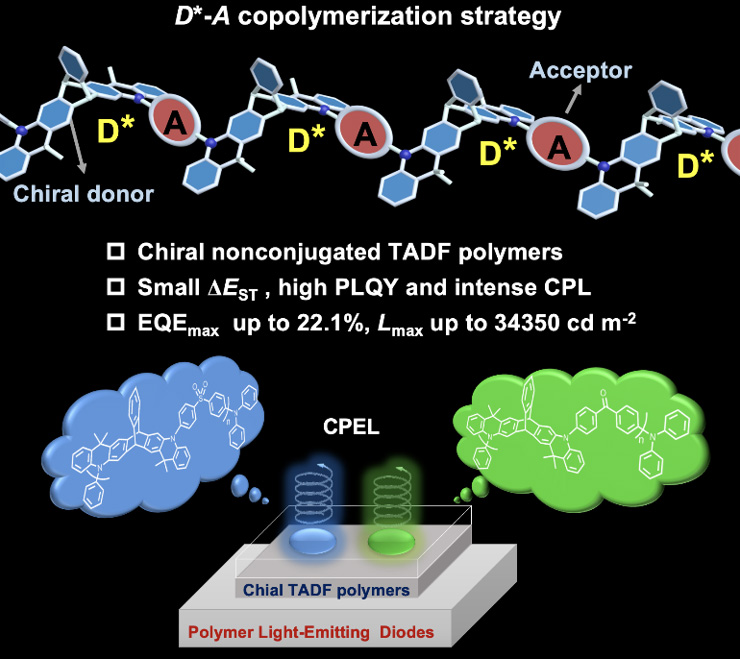Chiral TADF-Active Polymers for High-Efficiency Circularly Polarized Organic Light-Emitting Diodes
A beam of light can be divided into left-handed and right-handed polarized light by physical methods. Besides, chiral fluorescent materials can also emit different left-handed and right-handed polarized light when they are excited, which is called circularly polarized luminescence (CPL). In order to take full advantage of this unique property, circularly polarized organic light-emitting diodes can be fabricated (CP-OLEDs) with chiral fluorescent emitters to obtain circularly polarized electroluminescence (CPEL). With optimistic application prospects and importance in optoelectronic technology, CPEL has aroused sustained interest and attracted extensive attention.
In order to achieve highly efficient CPEL, thermally activated delayed fluorescent (TADF) materials have been widely used in CP-OLEDs since Prof. CHEN Chuanfeng’s group firstly reported TADF-based CP-OLEDs in 2018. TADF emitters have been regarded as third-generation luminescent materials since they can utilize both singlet and triplet excitons via reverse intersystem crossing (RISC) process. Therefore, TADF-based OLEDs can achieve theoretically 100% internal quantum efficiency (IQE).
Recently, Prof. CHEN Chuanfeng and his research group from the CAS Key Laboratory of Molecular Recognition and Function at the Institute of Chemistry, Chinese Academy of Sciences (ICCAS) reported their related progress on chiral-polymers-based CP-OLEDs which achieved intense CPEL properties. It is worth noting that this is the first report of CPEL detected from CP-OLEDs fabricated with chiral TADF-active polymers. This study was published in Angewandte Chemie. 2021, 133, 23811–23816.
The researchers designed and synthesized two pairs of chiral TADF polymers with a strategy of chiral donor-acceptor (D*-A) copolymerization which was firstly proposed by their group. The chiral donor moiety has a rigid triptycene scaffold which can provide chirality as well as break the conjugation of the polymer backbone. The benzophenone diphenyl sulfone unit and benzophenone unit were used as the acceptor moieties to prepare the two pairs of polymers.
The researchers then fabricated solution-processed CP-OLEDs using the two pairs of polymers as the emitting materials. The corresponding devices achieved outstanding performances with high maximum external quantum efficiency (EQEmax) of up to 22.1%, high maximum brightness (Lmax) of up to 34350 cd/m2. Besides, intense mirror-image CPEL signal was detected in such highly-efficient CP-OLED devices.
It is believed that the experimental results fully proved the effectiveness of the new strategy of D*-A copolymerization for realizing CPEL. The study shall give some inspiration and provide a new perspective for the research field of CPEL.
The study was supported by the National Natural Science Foundation of China, Beijing National Laboratory for Molecular Sciences and the Youth Innovation Promotion Association CAS.

Schematic representation of chiral-TADF-polymer-based CP-OLEDs.(Image by Prof. CHEN)
Contact:
Prof. CHEN Chuanfeng
Institute of Chemistry, Chinese Academy of Sciences
Email: cchen@iccas.ac.cn





